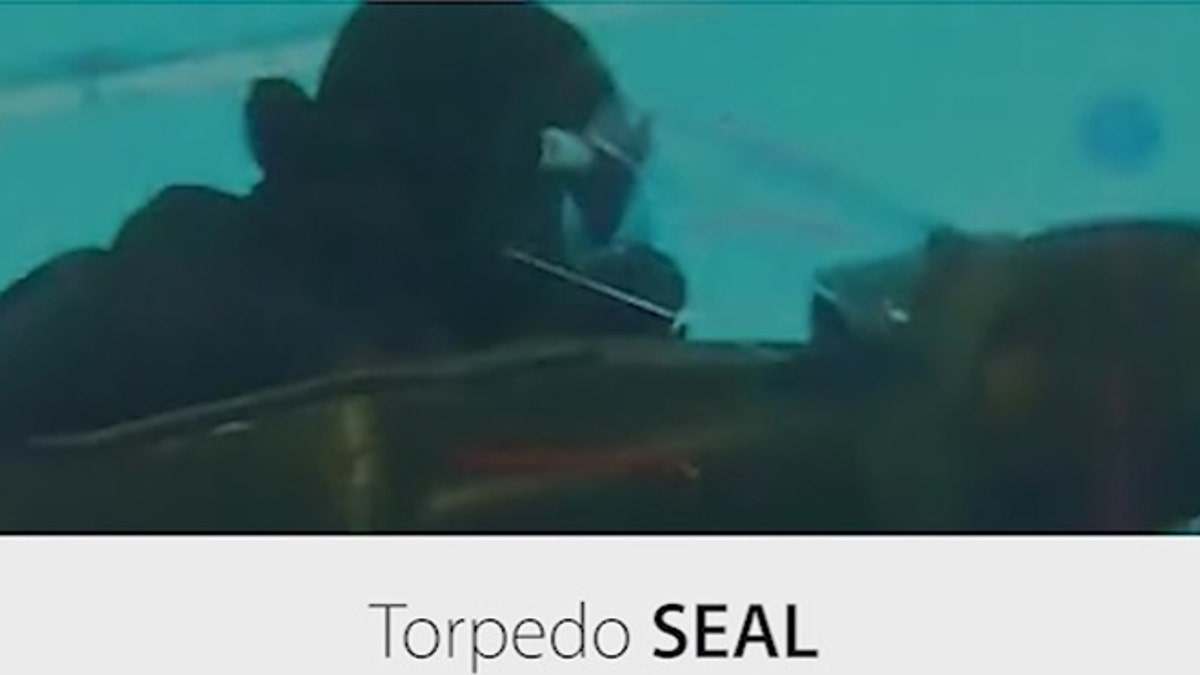
Torpedo SEAL can transport two divers and equipment, fully submerged. (James Fisher Defence)
James Bond was loaded into a torpedo tube and fired into the ocean in the 1967 film “You Only Live Twice” -- and now amphibious forces like Navy SEALs are getting exactly the same tech.
Only this is no movie.
Revealed this week at DSEI -- the world’s largest defense show -- the SEAL Pod vehicles come in three different models for different missions: Torpedo SEAL Sub SEAL and the Sea Carrier.
Shooting SEALs from Torpedo tubes?
The Torpedo SEAL vehicle uses a submarine torpedo tube to deploy two divers.
Stowed and carried within a NATO-standard torpedo tube or beneath the submarine outer casing, it just needs to be extended and it is ready to use. Torpedo SEAL achieves speeds of about 4 knots with a lithium polymer battery and, depending on requirements, one or two thrusters.
- Top Gear-worthy trucks and more from 2013 DSEI, the world’s largest defense show
- Air Force, DARPA plan new hypersonic vehicle
- Protesters, Syrian concerns at start of DSEI, world’s largest military tech show
- Would Dick Tracy have liked the Samsung Galaxy Gear?
- Russian resigns command of International Space Station for ‘better job’
This version is controlled by a single pilot and can carry one other warfighter and their equipment over more than 10 nautical miles when fully submerged.
The Steering Information Navigation Control system gives the warfighters real time communications, sensor and location information.
Why would you shoot SEALS out of torpedo tubes?
This sort of vehicle could be used for a wide range of purposes. It could be used to plant explosive devices or de-mine areas where adversaries have planted devices.
It could be useful beyond the self-evident amphibious forces. Special forces, law enforcement, counter-terrorism and border forces may also find the tech useful for operations like U.S. harbor protection and narcotics trafficking interdiction.
How about deploying SEALs from a submarine?
The Sub-SEAL version is larger, carries six warfighters, and can be launched from a surface craft or rotary-wing aircraft.
But it can also be deployed from underwater hangers attached to submarine casings.
Controlled by a pilot and navigator, these vehicles are operated underwater at depths of up to 30 meters. A vehicle like this would be used for missions where it is essential to stay submerged and deliver a team of six.
But if necessary, it can surface to communicate or for activities like reconnaissance approach.
Powered by lithium polymer batteries and a vectored-thruster, the Sub SEAL can sprint faster than seven knots and has a range of more than 70 km.
On the military front, it might be deployed for operations like mine countermeasures or anti-piracy, but it could also perform homeland security missions such as enforcing U.S. port protection.
SEAL Carrier
A SEAL Carrier can be launched from a surface ship and may even be airdropped from a medium lift helicopter or fixed-wing aircraft like a Boeing C-17.
It can also be transported by submarine, attached to the outer hull behind the sail or fin of a submarine.
One advantage the SEAL Carrier vehicle provides is that it can withstand depths of up to 150m -- meaning more stealthy range and longer missions.
This version can also carry a combat team of six and is controlled by a pilot and navigator.
Capable of travelling at more than 30 knots, surface propulsion is provided by an on-board diesel engine and water-jet.
It has the option of switching to submerged mode at any point, travelling at speeds around four knots, to provide a more stealthy approach. When it is traveling submerged, an electric motor and thruster is used for propulsion.
It can also be used as a sort of base for Unmanned Underwater Vehicles – that’s kind of like robots that operate autonomously underwater.
And very cool, SEAL Carrier can be used as a remotely operated weapons system.
A smaller version, Smart SEAL is available too.
The THOR Raider
There are two waterborne operation performances out on the river Thames at the 2013 Defense and Security Event (DSEI).
One of the stars making its debut is THOR, or the Twin Hulled Offshore Raider, made by CTruk and the Collaborative Amphibious Project consortium.
THOR can be launched from a surface combatant or a “mother ship” CTruk 50T and achieve speeds of more than 40 knots.
It uses Rolls-Royce Kamewa waterjet propulsors, TenCate Advance Armour ballistic protection and a Saab remote weapon station.
Rescuing Submarines in Distress
Are you man or woman enough to rescue a submarine in trouble?
Fuguro Subsea Services launched their DeepWorks Submarine Rescue Vehicle simulator this week at DSEI.
Event goers are challenged to rescue a submarine in distress against a clock ticking down and realistic tough sea conditions. Players jump in the simulator and try to navigate and dock a deep sea vehicle with the submarine in trouble in order to render assistance.
Each day of the show, results are tallied and the player who successfully docked with the sub at the most difficult level revealed. To the winner, a certificate -- and more important a bottle of whisky.
Ballet dancer turned defense specialist Allison Barrie has traveled around the world covering the military, terrorism, weapons advancements and life on the front line. You can reach her at wargames@foxnews.com or follow her on Twitter @Allison_Barrie.




















